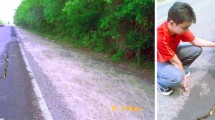Abstract
Transportation agencies spend millions of dollars annually to repair civil transportation infrastructure including pavements, earth structures and approach slabs distressed by soft compressible soils and expansive soils. Several research studies performed at the University of Texas at Arlington (UTA) focused on stabilizing these problematic soils so that they will provide better and more stable support to the transportation infrastructure. This paper focuses on a summary of two major distresses and mechanisms, and remedial measures for addressing these distress problems. A combined lime-cement stabilization method is fully evaluated in providing better support of pavement infrastructure, and these results are described here. Another major transportation infrastructure problem involving bridge approach slabs requires different treatment methods, and these results are briefly described. As a part of the recently completed research study assessments, both shallow and deep soil treatment methods for stabilizing soils are fully evaluated for their effectiveness in arresting the distress posed to the pavements and bridge approach slabs. These results along with a few future research needs are presented in this paper.
Similar content being viewed by others
References
Briaud, J.L., James, R.W., Hoffman, S.B., 1997. NCHRP Synthesis 234: Settlement of Bridge Approaches (the Bump at the End of the Bridge). Transportation Research Board, National Research Council, Washington, DC, p.75.
Hopkins, T.C., 1985. Long-Term Movements of Highway Bridge Approach Embankments and Pavements. University of Kentucky, Kentucky Transportation Research Program, USA.
Hunter, D., 1988. Lime-induced heave in sulfate-bearing clay soils. Journal of Geotechnical Engineering, ASCE, 114(2): 150–167. [doi:10.1061/(ASCE)0733-9410(1988)114:2(150)]
Jayawickrama, P., Nash, P., Leaverton, M., Mishra, D., 2005. Water Intrusion in Base/Subgrade Materials at Bridge Ends. TxDOT Report, FHWA/TX-06/0-5096-1, Texas Tech University, Lubbock, Texas.
Kramer, S.L., Sajer, P., 1991. Bridge Approach Slab Effectiveness. Final Report, Washington State Department of Transportation, Olympia, Washington.
Lin, Q.L., Wong, I.H., 1999. Use of deep cement mixing to reduce settlements at bridge approaches. Journal of Geotechnical and Geoenvironmental Engineering, ASCE, 125(4):309–320. [doi:10.1061/(ASCE)1090-0241(1999)125:4(309)]
Little, D.N., Males, E.H., Prusinski, J.R., Stewart, B., 2000. Cementitious Stabilization. Transportation Research Board Business Office, Washington DC, USA.
Mitchell, J.K., 1986. Practical problems from surprising soil behavior. Journal of Geotechnical Engineering Division, ASCE, 112(3):259–289.
Mitchell, J.K., Dermatas, D., 1990. Clay Soil Heave Caused by Lime-Sulfate Reactions. ASTM Special Publication 1135, p.41–64.
Petry, T., 1994. Studies of Factors Causing and Influencing Localized Heave of Lime-Treated Clay Soils (Sulfate-Induced Heave). Technical Report for US Army Corps of Engineers, Waterways Experiment Station, Vicksburg, MS.
Puppala, A.J., Hanchanloet, S., Jadeja, M., Burkart, B., 1999. Sulfate Induced Heave Distress: A Case Study. Proceedings of Transportation Research Board Annual Meeting, Washington DC, USA.
Puppala, A.J., Wattanasantichatoen, E., Intharasombat, L., Hoyos, L.R., 2003. Studies to Understand Soil Compositional and Environmental Variables Effects on Sulfate Heave Problems. 12th Pan American Conference on Soil Mechanics and Geotechnical Engineering.
Seo, J., 2003. The Bump at the End of the Bridge: An Investigation. Dissertation Submitted in Partial Fulfillment of the Requirements for the Degree of the Doctor of Philosophy, Texas, A&M University, College Station, Texas.
Sherwood, P.T., 1995. Soil Stabilization with Cement and Lime. HMSO Publication Center, London, p.14–55.
Sirivitmaitrie, C., Puppala, A.J., Saride, S., Hoyos, L.R., 2008. Combined Lime and Cement Treatment of Expansive Soils. ASCE Geotechnical Special Publication 178, Geo-Congress, New Orleans, Louisiana, p.646–653.
Stewart, C.F., 1985. Highway Structure Approaches. California Department of Transportation, Sacramento, CA.
White, D., Mohamed, M., Sritharan, S., Suleiman, M., 2007. Underlying causes for settlement of bridge approach pavement systems. Journal of Performance of Constructed Facilities, ASCE, 21(4):273–282. [doi:10.1061/(ASCE)0887-3828(2007)21:4(273)]
Author information
Authors and Affiliations
Corresponding author
Rights and permissions
About this article
Cite this article
Puppala, A.J., Chittoori, B.C.S. Transportation infrastructure settlement and heave distress: challenges and solutions. J. Zhejiang Univ. Sci. A 13, 850–857 (2012). https://doi.org/10.1631/jzus.A12ISGT9
Received:
Accepted:
Published:
Issue Date:
DOI: https://doi.org/10.1631/jzus.A12ISGT9




